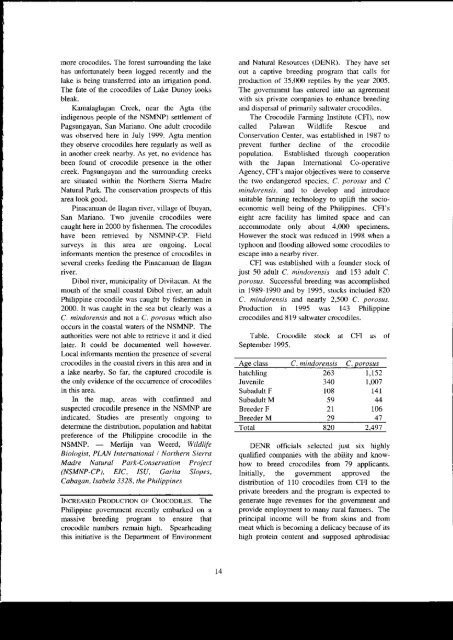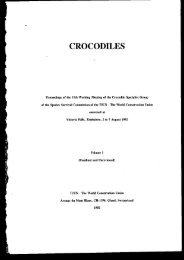size: 1779KB - Crocodile Specialist Group
size: 1779KB - Crocodile Specialist Group
size: 1779KB - Crocodile Specialist Group
Create successful ePaper yourself
Turn your PDF publications into a flip-book with our unique Google optimized e-Paper software.
more crocodiles. The forcst surounding the lake<br />
has unfortunately been logged recently and the<br />
lake is being transfened into an irrigation pond,<br />
The fate of the crocodiles of Lake Dunoy looks<br />
bleak.<br />
Kamalaglagan Creek, near the Agta (the<br />
indigenous people of the NSMNP) settlement of<br />
Pagsungayan, San Mariano. One adult crocodile<br />
was observed here in July 1999. Agta mention<br />
they observe crocodiles here rcgularly as well as<br />
in another creek nearby. As yet. no evidence has<br />
been found of crocodile presence in the other<br />
creek. Pagsungayan and the surrounding creeks<br />
are $ituated within the Northern Sierra Madre<br />
Natural Park. The conservation prospects of this<br />
a-rea look good.<br />
Pinacanuan de Ilagiur river, village of Ibuyzm,<br />
San Mariano. Two juvenile crocodiles were<br />
caught here in 2000 by fishermen. The crocodiles<br />
have been retrieved by NSMNP-CP- Field<br />
surveys in this area are ongoing, Local<br />
informants mention the presence of crocodiles in<br />
several creeks feeding the Pinacanuan de Ilagan<br />
river,<br />
Dibol river, municipality of Divilacan. At the<br />
mouth of the small coastal Dibol dver, an adult<br />
Philippine crocodile was caught by fishermen in<br />
2000. It was caught in the sea but clearly was a<br />
C. mitdorensis and not a C. porosus which also<br />
occurs in the coastal waters of the NSMNP. The<br />
authorities were not able t() retdeve it dnd it died<br />
later. It could be documented well however.<br />
l-ocal intormzmts mention the presence of several<br />
crocodiles in the coastal riyers in this area and in<br />
a lake nearby. So far, the captured crocodile is<br />
the only evidence of the occurence of crocodiles<br />
in this area.<br />
In the map, areas with contimled and<br />
suspected crccodile presence in the NSMNP are<br />
indicated- Studies ztre presently ongoing l(l<br />
determine the distribution, population and habitat<br />
pretbrence of the Philippine crocodile in the<br />
NSMNP. -._ Merlijn van Weerd,, Wildlife<br />
Biologist, PLAN International I Northern Sierra<br />
Madre Natural Park-Conservation Projecl<br />
(NSMNP-CP), EIC, 6U, Garita Slopes,<br />
Cabagan, Isabela 3328, the Phillppmes<br />
INCREASED PRoDUCTTON oF CRocoDIr-ES. The<br />
Philippine goverunent recently embitrlcd on a<br />
massive breeding prcgram to ensure that<br />
crocodile numbers remain high. Spearheading<br />
this initiative is the DeDartment of Environment<br />
and Natural Resources (DENR). They have set<br />
out a captive breeding program that calls for<br />
produotiun of 35,fiI) reptiles by the year 2005.<br />
The goverrurent has entered into an agreement<br />
with six private companies to eniance breeding<br />
and dispersal of primarily saltwater crocodileri.<br />
The <strong>Crocodile</strong> Faming Institute (CFI), now<br />
called Palawan Wildlife Rescue and<br />
Conservation Center, was established in l9li7 to<br />
prevent t'urther decline of the crocodile<br />
populrtion- Ertrbliched lfrough cooperation<br />
with the Japan Intematienal Co-operative<br />
Agency, CFI's major objectives were to conserve<br />
the two endangered species, C. porosus and C<br />
mittlorensis, and to devebp and iffoduce<br />
suitable farming technology to uplift the socioeconomic<br />
well being of the Philippines. CFI's<br />
eight acr€ facility has limited space and can<br />
accornmodate orly about 4.0(X) specimens.<br />
However the stock was reduced in 1998 when a<br />
typhoon and llooding allowed some crocodiles to<br />
escape into a nearby river.<br />
CFI was established with a founder stock of<br />
just 50 adult C. nittdorensis and 153 adult C.<br />
porosas. Successful breeding was accomplished<br />
in 1989-1990 and by 1995- stocks included 820<br />
C. ttindorensis and nearly 2,500 C. porosus.<br />
Producti()n in 1995 was 143 Philippine<br />
srosodiles and 819 saltwater crocodiles.<br />
Table. <strong>Crocodile</strong> stock at CFI<br />
September 1995.<br />
Age class<br />
hatchling<br />
Juvenile<br />
Subadult F<br />
Subadult M<br />
Breeder F<br />
Breeder M<br />
Total<br />
as of<br />
C. mindorensis C. porosus<br />
263<br />
| 1Sl<br />
340 l,007<br />
108 141<br />
59<br />
44<br />
2l 106<br />
29<br />
820 1 lo'7<br />
DENR officials selected just six highly<br />
qualified companies with the ability and knowhow<br />
to breed crocodiles from 79 applicants.<br />
Initially, the govemment approved the<br />
distribution of 110 crocodiles from CFI to the<br />
private breeders and the program is expected to<br />
generate huge revenues for the goyenxnent and<br />
provide employment to many rural farmers. The<br />
principal income will be from skins and fiom<br />
meat which is becoming a delicacy because of its<br />
high prctein content and supposed aphrodisiac<br />
I4
















